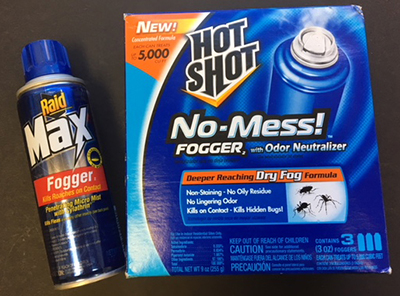Limitations of Home Insect Foggers (“Bug Bombs”)
ENTFACT-643: Limitations of Home Insect Foggers (Bug Bombs) | Download PDF | En Español
by Michael F. Potter, Extension Entomologist
University of Kentucky College of Agriculture
The University of Kentucky Entomology Department often receives questions from householders about total-release pesticide foggers, also known as “bug bombs." These inquiries have increased in recent years due to the resurgence of bed bugs. We seldom recommend these products for home insect control for the following reasons:
1. While foggers require little effort to use, they seldom resolve, and can exacerbate, indoor pest problems.

Fig. 1: Total release insecticide foggers (‘bug bombs’) are widely marketed to the public.
Most foggers are designed to be placed in the center of a room on a chair or table, and activated by depressing or removing a tab at the top of the can. The entire contents are released upwards, into the airspace, where the aerosol droplets remain suspended for a period of time and then gradually settle onto floors, counter tops and other surfaces. Prior to application, drawers, cabinets and closets are supposed to be opened to enhance coverage in areas where pests are likely to be hidden. When applied in this manner, very little insecticide actually penetrates into cracks, voids, and other secluded locations where cockroaches, ants, bed bugs, and most other household pests congregate and spend most of their time.

Fig. 2: Foggers seldom reach into hidden places where most pests hide.
Many insect foggers contain pyrethrin as an active ingredient. While pyrethrins are somewhat effective against exposed flying insects such as house flies, they are seldom lethal to roaches, ants, bed bugs, spiders, silverfish, and other crawling pests. The ingredients within ‘bug bombs’ also tend to be repellent, causing insects to scatter and move deeper into walls, crevices, and other hard-to-reach areas.
When insecticides are needed to eliminate a pest infestation, results will be better if the spray, bait, etc., is applied directly into areas where pests are likely to be hiding. Targeted insecticide applications tend to be more effective against all varieties of household pests, including fleas. Flea control products that can be dispensed by hand can be directed under beds, behind furniture, and into other hidden locations less accessible to foggers.
2. It is imprudent to allow pesticide residues to settle onto counter tops, bedding, seating, and other exposed surfaces.
The directions for use accompanying total-release foggers specify that exposed food, utensils, and food preparation equipment and surfaces be covered and cleaned before reuse. However, many householder fail to read and follow these precautions. Another potential hazard is related to a common ingredient in bug bombs, pyrethrin, which is derived from chrysanthemum flowers. Occupants with asthma and other respiratory ailments can react severely when pyrethrins and other irritating, volatile compounds are used indoors. According to label instructions, people and pets are not supposed to remain in the treated area, but are not necessarily required to leave the dwelling.
3. The ingredients in some bug bombs may be flammable when used near open flame.
There have been several house fires involving insect foggers when users neglected to extinguish pilot lights on stoves, furnaces, and other household appliances Fires have also been caused when the ‘bombs’ are set off in the presence of a lit cigarette.

Fig. 3: Bug bombs can cause serious accidents when used incorrectly.
In summary, there are many ways to wage war against pests. One of the least effective involves using a fogger. Although other methods may require a bit more effort, results usually will be better and more permanent. Oftentimes, the solution is as simple as a fly swatter, vacuum, or door sweep. One of the few instances where total-release foggers might be useful is where cluster flies, paper wasps, etc. are infesting attics, outbuildings or other cluttered, hard-to-reach areas. Refer to our other entomology extension publications for specific suggestions for managing these and other insect pest problems.
Revised 10/9/2018
CAUTION: Some pesticides mentioned in this publication may not be legal in your area of the country. If in doubt, please consult your local cooperative extension service or regulatory agency. Furthermore, ALWAYS READ AND FOLLOW LABEL DIRECTIONS FOR THE PRODUCT YOU ARE USING.
Please note that content and photos in this publication are copyrighted material and may not be copied or downloaded without permission of the Department of Entomology, University of Kentucky.
